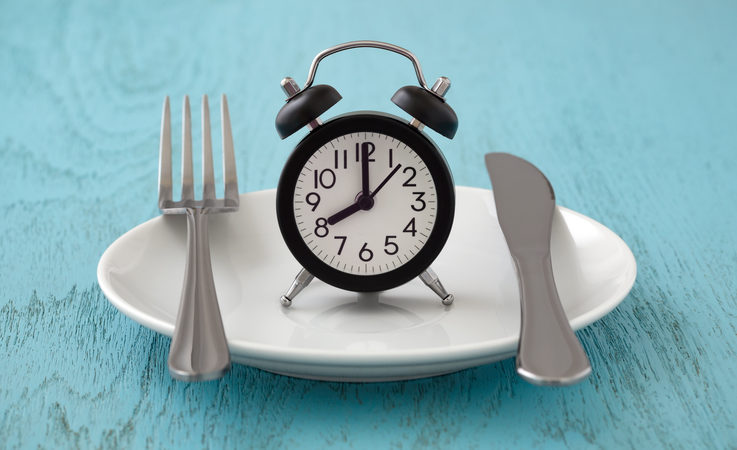I’ll admit it—my roots in fitness run deep; I’m what you’d call “old school.” “Back in my day,” as the saying goes (I was the editor for the seminal training and exercise magazine Muscle Media during the ‘90s), hardcore fitness enthusiasts ate every few hours to “stoke their metabolisms” and maintain high energy levels. In other words, they grazed throughout the day rather than, for example, eating “just” the traditional three square meals a day (And NO ONE was talking about intermittent fasting or fasting of any kind).
Their meals looked an awful lot like the stereotypical bodybuilding fare. They ate a lot of lean protein source (typically chicken breast or tuna or another white fish), kept fats low, and often ate baked potatoes (with salsa or steak sauce instead of butter) along with a side of steamed broccoli.
Of course, the second any workout ended, they slammed a post-workout protein shake often with some high-glycemic, sugar-spiking carbs (like some maltodextrin or a very ripe banana) in it to “shuttle the protein and nutrients directly into the muscles for maximum growth.”
I started training with weights with my Dad when I was 13 years old, and I clearly remember what the protein powders used to taste like. Let’s just say there weren’t enough bananas to cover the funky taste and chalky texture. And let’s not even talk about those so-called protein bars!
Now, of course, we’ve learned a lot in the last couple of decades: fat is no longer to be feared (and is, in fact, quite necessary to build a strong, healthy body), protein powder can be high-quality and taste like melted ice cream (or at least close enough to want to lick the bowl), and many people would chagrin at the notion that eating a carb-laden baked potato is somehow healthy (particularly when slathered with steak sauce).
But what about eating every few hours—that’s still correct, isn’t it?
We need to keep our metabolisms humming all day long and support steady blood sugar levels, and the best way to do that is to stay fueled by eating every few hours…right?
Yeah, nope.
Intermittent Fasting & Metabolic Flexibility
We’re learning more about nutrient timing as well, and it turns out that going several hours—even much of the day—without food (known as intermittent fasting) actually may offer benefits such as:
- Improved blood fats (e.g., cholesterol, triglycerides)
- Increased cellular turnover and repair
- Reduced blood pressure and resting heart rate
- Reduced inflammation
- Increased fat burning and ketone production
- Increased metabolic rate and function
- Improved blood sugar control
- Increased insulin and leptin sensitivity
- Improved appetite control
- Improved cardiovascular function
- Increased growth hormone release
- Reduced oxidative stress
- Reduced body weight, fat, and visceral fat
- Increased resistance to stress
As I read through this list the first time (more than a year ago), I thought, “If it sounds too good to be true, it probably is.” Must just be another fad that will fade with time. (In fact, I vaguely remembered reading about intermittent fasting in some old bodybuilding magazines, though they were either quickly dismissed or simply drowned out by the mainstream recommendation of more frequent feeding.)
Besides, I can’t go without breakfast (and I wouldn’t want to, gosh darn it). In fact, if I go too long without food, I get the shakes, a headache, and seriously cranky (what my friends and family often refer to as getting “hangry”) as well. (While I’m overall healthy, I have always had to be mindful about managing my blood sugar levels.)
So, I’m out on intermittent fasting. No need to give this one a try. Next…
But I kept reading more of the articles, started diving into the actual research, looking at the history, and found it was actually pretty darn convincing and compelling. Ummm… could this be the real thing rather than a fad? Still, it probably isn’t right for me—that old blood sugar thing.
Then I came across Coach Tim’s article on Metabolic Flexibility. And bells started ringing in my head.
Could intermittent fasting, or “IF” as it’s often called, help me improve my metabolic flexibility? Could the “old blood sugar thing” be a sign that my body wasn’t trained to use its own stores of energy (namely, FAT) for fuel, and instead, it was reliant on the foods I was “fueling” it with all day long?
Could IF help teach my body to more efficiently and effectively switch between using carbs and fats for fuel? And could it improve my blood sugar regulation to avoid horrible crashes on those days I didn’t plan well enough to eat every few hours?
And could it really increase fat loss (especially around the belly) without actively restricting calories? And improve my health as I’m getting older?
What the heck, I’ll give it a try for a week or two and see what happens, I decided.
I mentioned this in a meeting to Coach Tim, and as usual, he was extremely kind to ask about my plan and then share his extensive expertise to help me get the biggest “bang for the buck” from my experiment to better “flip the metabolic switch.” Here is his expert advice and recommendations based on my plan:
- The metabolic switch (from burning glucose to fat/ketones) generally gets flipped after about 12 – 16 hours of fasting, and the level of ketones increase as the duration of fasting expands. While I often recommend a 6-hour feeding window, a 12- to 16-hour fast—with an 8- to 12-hour feeding window—can be sufficient to flip the metabolic switch (particularly with exercise baked into the fasting window).
- Exercise, from a physiological standpoint, is like an accelerated fast (by helping deplete liver glycogen, which is intricate to the metabolic switch being flipped). The duration and intensity of exercise plays a substantial role in the degree of acceleration.
- If you’re exercising roughly 10 hours or so into your fast (as I was), I think it’s safe to say that you’d be on the verge of flipping your metabolic switch during or shortly thereafter.
- My approach is similar to yours where I’m typically eating 2 – 3 hours after exercise, and truth be told, I find that 2- to 3-hour time period to be very productive, clear, and energetic. I suspect that has to do with heightened levels of ketones.
- My personal preference is to save intense exercise for the afternoon/early evening when circadian rhythmicity is more favorable. In other words, I like more low-intensity activity in the morning (to take advantage of heightened fat burning) and higher-intensity activity later in the day. I know that’s not feasible for everyone, however. (That wasn’t feasible for me as I work out with my son, which I love, and that means early-morning workouts for me.)
- (I also told Tim I had coffee with cream during my workouts.) Instead of having coffee with cream, I think it might be interesting to experiment with coffee PLUS Keto Elevate (i.e., MCTs). I go back and forth a bit on this since I question whether the MCTs would be glycogen-sparing. However, the MCTs will increase ketone levels, and I think that may help facilitate the metabolic shift—especially when used 1. later into the fast; and 2. preceding exercise.
My Personal Intermittent Fasting Journey
Okay, I have been convinced to give it a try and been offered coaching advice given my personal situation. Now, all that’s left is to get started. Tomorrow.
Just kidding. I’ve actually already given it not a week or two but three full weeks. And spoiler alert, I’m planning on continuing as it’s been so easy and rewarding. (And I really did have my doubts that I could make it even one day, much less a week or more.)
Here’s my typical schedule (though it does vary):
My IF Morning
Wake up at 4:45 a.m. to work out with my son (who’s 13) with weights for about an hour. I NEED my coffee at this time, so I have one cup mixed with Keto Elevate (which creates a really yummy, slightly sweet, creamy coffee!) or a half tablespoon of heavy cream. I know that means I’m technically breaking my fast, but I use a half serving, and my biggest goal is to increase my metabolic flexibility, so I am only consuming fat with no protein or carbs. And I just can’t drink black coffee.
My son and I are currently on a muscle-building program (he’s really getting strong!), so we lift heavy weights at least three days a week. Then I take an extra 5 to 15 minutes to stretch and do some mobility work. (Three days a week, we do some type of cardio—often just a quick HIIT workout.)
Then it’s off and running to leave the house by 7:00 a.m. to get him to school. I’m back home at 8:00 a.m. to start my day. (In the past, I would make breakfast as soon as I walked in the door.)
The first few days, I did feel hungry and headachy, especially if the drive was stressful (e.g., traffic, snow and ice, etc.). But I quickly realized that I was probably eating mostly out of habit, and there was an easy way to prevent the headache altogether—drink water! Another benefit of IF is that it has taught me how to better determine if I’m truly hungry or just thirsty, and quite often, I’m really just thirsty. So, I’ve been both improving my hydration and practicing more mindful eating over the last few weeks!
At first, I was holding off and eating my breakfast around 9:30 a.m., and I was ravenous. But within a week, I found that with a bottle of water by my side, I started enjoying that clarity Coach Tim had mentioned and would often just be working until 10:30 or 11:00 a.m. before I started to feel hungry.
When I Broke My Fast
Another interesting thing started happening. Whether I broke my fast with oatmeal with Platinum 1 protein, Ageless Multi-Collagen, and a tablespoon of peanut butter, had eggs with plenty of veggies, or enjoyed protein pancakes, I would start to salivate as I prepared my breakfast. My brain was better preparing my digestive system because I was getting true hunger signals. By eating frequently throughout the day (e.g., 5 times) for so many years, I had been eating on schedule rather than when I was hungry, and I hadn’t realized I had lost touch with my body’s signals.
The rest of my days, as far as eating goes, were pretty normal: lunch followed by a walk (which can also help with metabolic flexibility) with my dogs and dinner with the family around 6:00 p.m. And the evenings are no problem at all. After dinner, I typically don’t even think about food.
At the “end” of my intermittent fasting journey, I now eat breakfast between 10:30 and 11:00 a.m. and finish my final meal by 7:00 p.m. with few deviations. So, I have an 8- to 8 ½-hour feeding window with a 15 ½- to 16-hour fast daily.
So, How Did Intermittent Fasting Impact Me?
The biggest benefit I have experienced is that I no longer get the shakes when I miss a meal. If I’m too busy, away from the house, or just forget to eat, I feel fine. To me, this makes it pretty evident that I’m improving my metabolic flexibility, and my body is becoming much more efficient at flipping the metabolic switch (from relying sugar to burning fat).
Another interesting experience occurred when we celebrated my husband’s birthday with a “pieluck” (everyone in the family brought different pies). Let’s just say “indulged.” In the past, after overdosing on sugar, I would have been buzzing and would have had a difficult time sleeping . Yet, this time, I didn’t feel bad at all—no difficult night sleeping and no food hangover the next day. I suspect it’s because I’ve been improving my insulin sensitivity with the regular workouts combined with IF. (Though that’s just a theory.)
While I don’t have any objective data (like lab results) to tell me if I’ve successfully switched the metabolic switch with IF, I simply feel better, I haven’t crashed or gotten the shakes, and my energy levels are much more stable—even though I’m not eating as often!
Of course, this is just an “n = 1” experiment, and these are anecdotal results from my personal journey. It’s true that intermittent fasting isn’t for everyone. But I have had a highly positive experience, and it seems to be a useful tool for me.
Oh, and in case you’re wondering, I didn’t restrict calories, “diet,” or even watch what I ate (as evidenced from the ol’ pieluck “experiment”). And in the three weeks, I didn’t lose (or gain) even a single ounce of weight, though in retrospect, I should have tracked my body fat percentage. But I did lose two inches off my waist—in 21 days—without dieting. And that pretty much rocks. Yep, I’m going to keep this up.
And if you decide to embark on your own intermittent fasting journey (or if you’ve already jumped on the IF bandwagon), we’d love to hear about your experiences!









